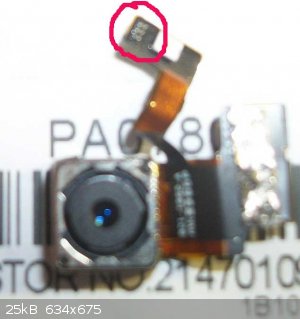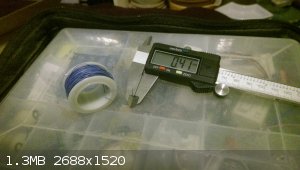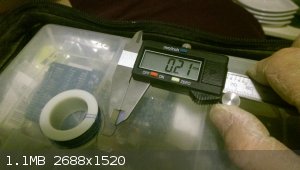wg48
National Hazard
   
Posts: 821
Registered: 21-11-2015
Member Is Offline
Mood: No Mood
|
|
Double check what you buy
The small camera I ordered for £2.00 including postage arrived today. I want to build a system to view spinning drops that is sufficiently small
that it will not get in the way..
Oops! I should have thought more about how I was going to make connections to it. The pic below shows the item. The red circle contains three
connections for power and video, about 1,4mm. total width.

|
|
|
violet sin
International Hazard
    
Posts: 1475
Registered: 2-9-2012
Location: Daydreaming of uraninite...
Member Is Offline
Mood: Good
|
|
Well, radio shack has some affordable and small wire. With shielding on

It is for wrapping posts on older prototype boards. -$5 US for more than I will use in a couple years.

Duh, one pic with shielding stripped right?
[Edited on 10-2-2018 by violet sin]
|
|
|
NEMO-Chemistry
International Hazard
    
Posts: 1559
Registered: 29-5-2016
Location: UK
Member Is Offline
Mood: No Mood
|
|
You got a couple of options, mouser do a crimp on connector that fits. i cant find a part number at the mo. Also check the pi foundation forum.
Or you got pogo pins option, you should be able to find a suitable 'rig' with pogo's on.
Even with liquid flux you wont solder that, you will get tracking at that distance. Ok it can be done but you would need liquid flux and solder paste,
also a solder stencil to get away with it.
If on the other hand your a soldering pro, use an acetate sheet for laser printers, get some ultra fine needlework pins like for butterflies.
Then you pin the acetate to the holes with the pins, leave a good bit of shaft, leave one hole unpinned, that hole you make first with the thin pin,
then a needle or bigger pin.
This acts like a solder mask, spread the solder paste over this hole with the pin removed, solder the wire with the acetate in place.
Do for the others one by one, its a real bitch though.
Hmmm £2
means you must UK? if you get stuck I will give it a go for you.
[Edited on 10-2-2018 by NEMO-Chemistry]
[Edited on 10-2-2018 by NEMO-Chemistry]
[Edited on 10-2-2018 by NEMO-Chemistry]
|
|
|
ficolas
Hazard to Others
  
Posts: 146
Registered: 14-5-2016
Member Is Offline
Mood: No Mood
|
|
those are called flexible flat cables (FFC), and yea, there is no way you are soldering that, but you may be able to find a connector for it, that you
can solder onto a board, or that has header pins for you to attach cables.
Like this, but the size is probably not right
https://www.ebay.es/itm/10-X-FFC-FPC-CONNECTOR-RECEPTACLE-3W...
|
|
|
Sulaiman
International Hazard
    
Posts: 3558
Registered: 8-2-2015
Location: 3rd rock from the sun
Member Is Offline
|
|
I can not see the end of the cable clearly but on the assumption that there are six pads;
if attempts to connect to the cable fail then you may be able to solder to the pcb ?
So before you damage the cable,
determine which connections available at the end of the cable you need, then using a dmm or similar determine which pins on the pcb correspond to
your required connections.
CAUTION : Hobby Chemist, not Professional or even Amateur
|
|
|
aga
Forum Drunkard
    
Posts: 7030
Registered: 25-3-2014
Member Is Offline
|
|
If you have some thin enamelled copper wire, around 38 SWG, you can burn off the enamel and tin the copper just using the tip of the iron and plenty
of solder.
Use some tape to get them to line up with the connectors and then solder them all in one go.
... assuming the iron won't just melt the whole thing.
|
|
|
NEMO-Chemistry
International Hazard
    
Posts: 1559
Registered: 29-5-2016
Location: UK
Member Is Offline
Mood: No Mood
|
|
Those are the same as laptop cameras aga, the bugger is the middle holes. You got no choice but to use solder paste and a acetate mask. I got through
maybe 10 or 12 laptops cameras (salvaged laptops) before I got it sorted, tinning the wire for some reason dosnt work with what ever the cable
material is, its a bit like capton tape, except unlike capton tape it does allow solder to flow freely across even with a good splodge of liquid flux.
What they call in the trade a real mare 
|
|
|
unionised
International Hazard
    
Posts: 5102
Registered: 1-11-2003
Location: UK
Member Is Offline
Mood: No Mood
|
|
That's what conductive glue is for.
(you may need to employ someone with a very steady hand...)
|
|
|
vmelkon
National Hazard
   
Posts: 669
Registered: 25-11-2011
Location: Canada
Member Is Offline
Mood: autoerotic asphyxiation
|
|
I would build a springy metal thing to make contact with the leads. That is what I did to charge a Li-ion battery when I did not have the official
charger.
Signature ==== Is this my youtube page? https://www.youtube.com/watch?v=tA5PYtul5aU
We must attach the electrodes of knowledge to the nipples of ignorance and give a few good jolts.
Yes my evolutionary friends. We are all homos here. |
|
|